May 30, 2016
Last week, I spoke at the Biohacking Summit in London.
The event was created by some of the smartest minds in biohacking, including my friend and the most self-quantified man in Europe, Teemu Arina, pictured below. This guy literally wears a space-agey shirt that tracks his entire body metrics and then links up all his metrics to a computer.

And while I'm certainly not quite so extreme that I wear self-quantified clothing and electronic skull devices, I am indeed a big fan of “better living through science”.
In the brand new nutrition section of his Biohacker's Handbook, Teemu and his team of global biohackers have amassed a collection of some of the most potent, unique and effective nutrition biohacks I've ever seen.
This book is selling like cupcakes in Europe, and includes 170+ pages, 100+ illustrations based on 450+ scientific references, and over a year of work from a team of six biohackers, including a medical doctor.
Inside, you'll discover topics such as:
– Optimizing digestion and gut bacteria
– Brain-gut axis and mental performance
– Optimal food preparation and cooking methods
– Upgrading daily food items and ingredients
– Avoiding toxins, allergens and antinutrients
– Genetics, self quantification and individual nutrition
Here's just a little sneak peek of the video trailer for the book, in which Teemu is using a self-quantified sleeping device to detect when he reaches his lightest stage of morning sleep, at which point the device both awakens him and launches his breakfast into preparation in the kitchen…
OK, now, don't run away scared if you're not an extreme biohacker like a few of the folks in the video above. The book is actually extremely practical and easy-to-read. Each chapter is split into four essential parts:
1. An introduction based on a story.
2. A theoretical section that discusses the hackable systems.
3. A technological section that describes the biological and technological tools needed for upgrading oneself.
4. A measurement section that describes the tools needed to track progress.
In addition, the book’s bonus materials contains product links, bonus materials, videos, audio recordings, book and article recommendations, extra scientific references with hyperlinks, and the opportunity to send feedback and questions to the biohacking team that wrote the book as you read via a browser or a mobile device.
Anyways, I've literally just finished reading the entire thing in extreme detail, and (in the same spirit as last month's “Best Health Books Of 2016” article) I'm now going to give you just a few of the major takeaways I discovered while reading it. I guarantee you're going to find a few gems in this article and in the book that you never knew about how to biohack your diet and get full advantage from the foods you eat (along with a few very unique hangover and alcohol drinking tips).
Let's dive in…and as usual, leave any questions, comments or feedback below the post…
Diet Biohacking Lesson #1: Look For Amines
Food hypersensitivity can be caused by the histamine, tyramine or other “biogenic amines” present in the food (chocolate, red wine, tuna or fermented ingredients such as cheese). In some cases, food (for example tomato or pineapple) may release histamine in the body. This is referred to as Histamine Intolerance Syndrome (HIS). Individuals with HIS typically have a low level of diamine oxidase, an enzyme that metabolizes histamine in the system.
So…if you get headaches, brain fog, low energy or other issues, then you should review your diet for the following and experiment with eliminating any that happen to be major staples:
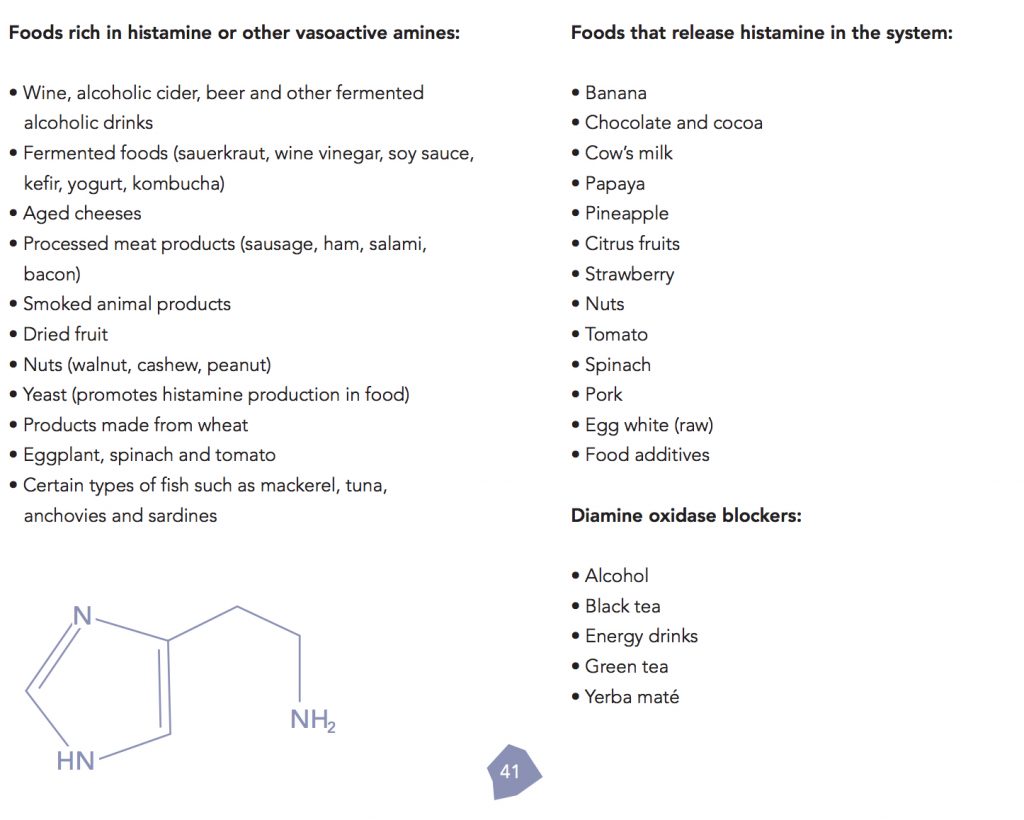
Diet Biohacking Lesson #2: Use Natural Foods To Support Digestion
Sure, you can take probiotics, digestive enzymes and other spendy supplements to support digestion, but you should also get familiar with natural, easy-to-afford foods that support digestion, including:
• Fresh carrot juice (supports intestinal mucous membranes)
• Celery juice (promotes intestinal movements and alleviates constipation)
• Level of hydrochloric acid (betaine hydrochloride, HCL)
• Carminatives that reduce gas in the intestine: orange, fennel, ginger, cinnamon, cardamom, cilantro, caraway, licorice, oregano, parsley, peppermint oil, rosemary, sage, lemon balm, dill, thyme, garlic.
• Bitters that stimulate the production of stomach acids and digestive enzymes: Jerusalem artichoke, Angelica sylvestris root, yellow gentian, Angelica archangelica root
• Other foods that support digestion: Aloe vera, pineapple, chia seeds, chlorella, sauerkraut, currants, Iceland moss, chamomile, cranberries, oats, meadowsweet, blueberries, oregano, chaga mushrooms, papaya, linseeds, horse radishes, lingonberries, psyllium, rhubarb root, plantago, rosehip, spirulina, sea buckthorn, raspberry leaf, wheatgrass, valeriana.
Diet Biohacking Lesson #3: Careful With Foil
Tinfoil is typically used for stewing meat or fish on a grill or in an oven. Stewing in tinfoil reduces the formation of glycotoxins and HCAs, but the amount of aluminum released into the food is up to 6 times
the amount considered a safe daily upper limit. Here are some other cooking items you should include in your kitchen instead:
Diet Biohacking Lesson #4: Try DIY Sous-Vide
Sous-vide cooking is a very efficient and flavorful technique to evenly and perfectly cook food, but home sous-vide cookers can be extremely expensive. So here's a DIY version from the book:

Diet Biohacking Lesson #5: Get To Know Your Genes
Recently, I conducted a very interesting self-analysis of my 23andMe genetic data to see how sensitive my body is to the sleep-disrupting effects of blue light at night, since some people are more sensitive than others. Here are the exact instructions on how you can do that too.
But of course, genes also influence diet.
Nutrigenomics involve the study of the effects of nutrition on the function of genes. For example, researchers at the Norwegian University of Science and Technology (NTNU) have found that cutting sugar consumption (to less than 40 percent of the energy content of the meal) can lower the risk of cardiovascular diseases, dementia, some types of cancer, and diabetes.
Genes affect metabolism in a comprehensive way. Because of this, it would be a mistake to expect that a particular diet (such as a low-fat or low-carbohydrate diet) would produce the same results for everyone.
Listed below are just a few gene of the many gene variants described in the book that are worth noting in terms of diet:
• Apolipoprotein E (APOE) is crucial for fat metabolism, particularly for breaking down lipoproteins (including LDL). People with types 3/4 and especially 4/4 are associated with high cholesterol levels, carotid artery disease and Alzheimer's disease. Interestingly, although the cognitive processes of individuals with a type 4 variant deteriorate faster than usual, their brain function early in life is enhanced, particularly in the hippocampus.
• PPARG (Peroxisome Proliferator-activated Receptor Gamma) is a nuclear protein that has an effect on obesity. The Ala type is associated with a lowered risk of developing type 2 diabetes. However, a study conducted on mice found that for individuals with this variant, a high-fat diet increased obesity more rapidly and thus formed a predisposing factor for diabetes.
• Variant rs4988235 of the MCM6 genemaffects the production of the lactase enzyme (LCT). Individuals with a T type variant usually tolerate lactose. The C/T type variant is associated with obesity. Individuals with a C/C type variant are likely to be lactose intolerant.
• Variant I148M of the PNPLA3 gene. This variant of the PNPLA3 gene related to fat metabolism slows the breakdown of triglyceride fats in the liver and thus promotes the onset of fatty liver disease, which could affect your decision on how much “butter-in-your coffee” you think about drinking.
• Variant 164A>C of the CYP1A2 gene. Caffeine, mycotoxin and paracetamol (among others) are broken down in the liver mainly by the CYP1A2 enzyme. Each individual's CYP1A2 enzyme system functions at
a different rate. Individuals with a type C variant have a slow enzyme system. For these individuals, drinking coffee can increase the risk of heart attack214 and/or high blood pressure.
•Variants C677T and A1298C of the MTHFR gene and variant A66G of the MTRR gene. Methylene tetrahydrofolate reductase (MTHFR) is an enzyme needed to convert folic acid and certain other forms of folate into methylfolate (5-MTHF). Folic acid can be found in vitamin supplements and vitamin-enriched foods. Individuals with these variants are unable to efficiently convert folic acid into active folate. This results in a high homocysteine level, a known risk factor for cardiovascular diseases, particularly in individuals with variants C677T and A66G. Switching from folic acid to more efficient methyltetrahydrofolate is recommended.
• ANKK1 is fundamentally linked to the dopamine D2 receptor (DRD2), i.e. reward and motivation. A mutation in this gene is a predisposing factor for addictive behavior (alcohol, tobacco, sugar, gambling, opiates).
-The effects of coffee depend on one's genetic makeup. For example, the CYP1A2 gene affects the body's ability to remove caffeine from the system, and the VDR gene is associated with caffeine's negative effects on bone health. For these reasons the same amount of caffeine may have a different effect on different individuals.
If you get a 23andme genetic test, you can do a self-evaluation for any of these genes, or the many others discussed in the book.
Diet Biohacking Lesson #6: Eat Copious Amounts Of Plant Matter, Along With Small Amounts Of Berries & Even Smaller Amounts Of Fruit
Here is an illustration from the book that I found to be quite helpful in terms of visualizing what the average breakdown of fruits, berries and vegetables should look like:
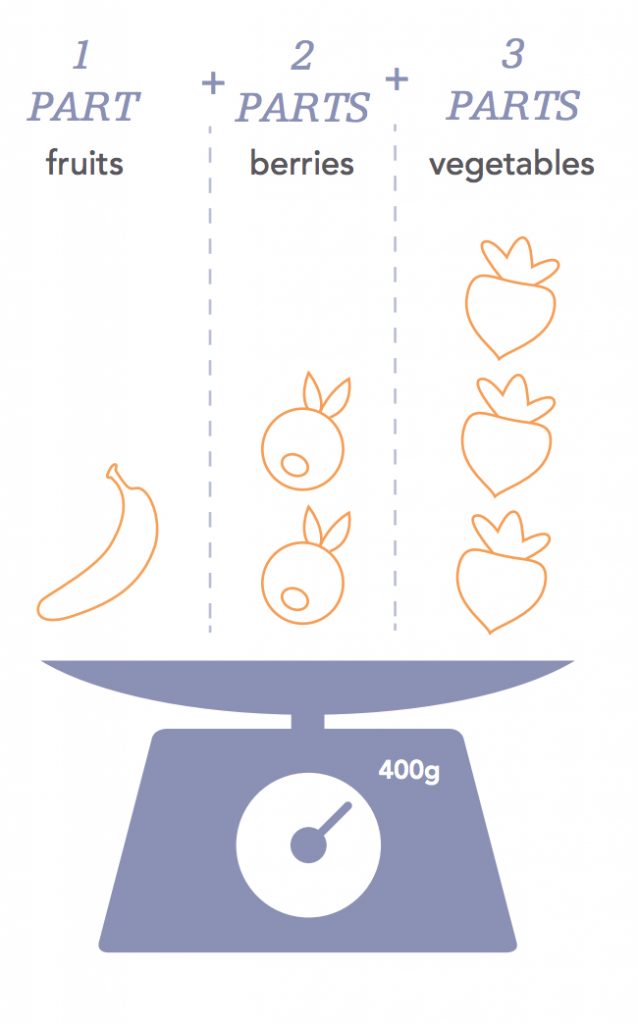
Diet Biohacking Lesson #7: Kale Ain't All It's Cracked Up To Be
You're probably familiar with the popularity of kale as a superfood, but there are four other leafy greens that beat it out big-time. Check out the graph below:
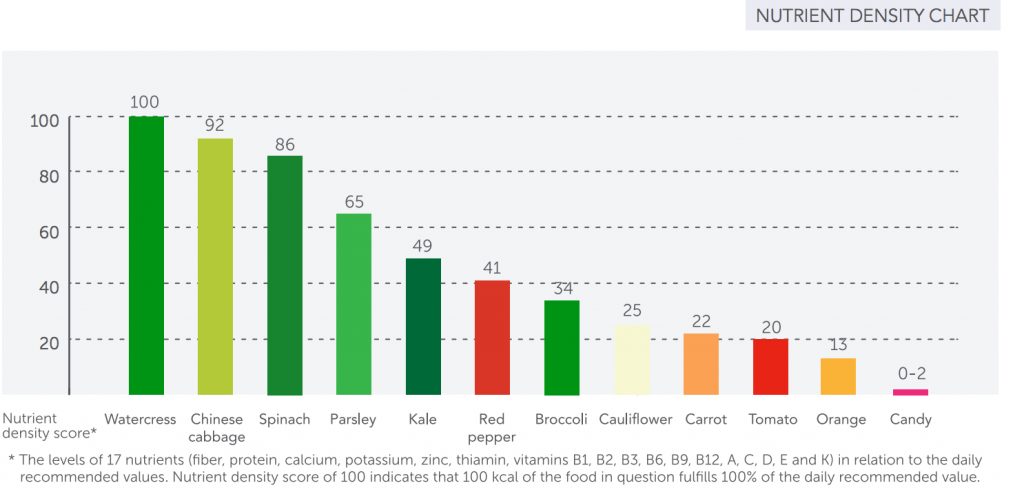
Diet Biohacking Lesson #8: Don't Eat Your Salt & Honey Plain
Biohack your sea salt. Biohack your raw honey. Why not make these condiments even more flavorful and nutritious? Here's a couple ideas from the book:
-Mix together several different types of salt and dried herbs (such as rosemary, basil and mint), if desired. This increases the nutritional density, flavor and aromas of the salt used. My favorite salt to use? This Aztec stuff.
-Mix genuine vanilla, spirulina or for example nettle seeds into honey. Honey is a wonderful preservative and the spices or herbs mixed in it give a nice touch to its flavor.
Diet Biohacking Lesson #9: Make Ice Cream In A Blender
We actually made this exact ice cream at the Upgraded Biohackers' Dinner, which was part of the Biohackers' conference in London. I highly recommend the recipe (no fancy ice cream maker required):
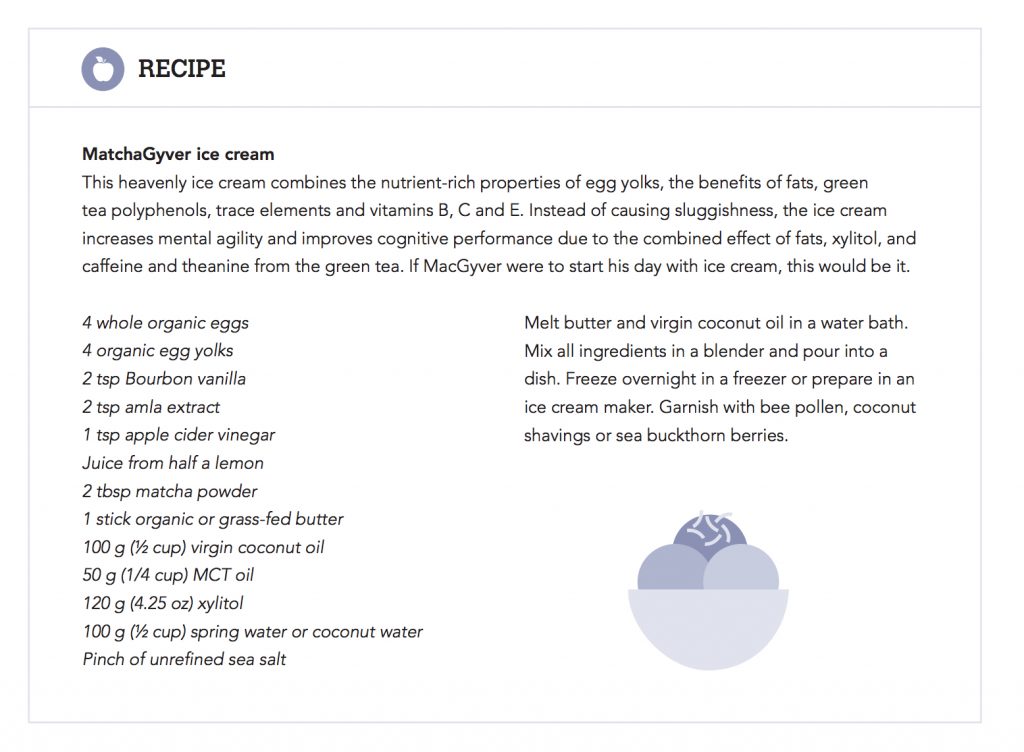
Diet Biohacking Lesson #10: Choose Your Cinnamon Wisely
Coumarin is an aromatic compound found naturally in many plants. Its main source in food is cinnamon. In Europe and the United States, Chinese cassia (cinnamomum cassia) is the most common type of cinnamon used, and it contains large quantities of coumarin.
It is only the more rare, more expensive Ceylon cinnamon (cinnamomum zeylanicum), which is very good for controlling blood sugar, that contains very little coumarin. This is important because coumarin can be toxic to the liver (hepatotoxic). In 2004 the European Food Safety Authority (EFSA) set a tolerable daily intake for coumarin at 0.1 mg per one kilo of body weight per day. So the regular liberal use of non-ceylon cinnamon, such as you'd find at Starbucks, is not recommended.
Diet Biohacking Lesson #11: Go Beyond Steak
Unbalanced animal consumption (for instance, only favoring muscle meat and steak instead of organ meat or bone broth) can cause an amino acid imbalance in the body. Muscle tissue is rich in methionine, the excessive consumption of which has been found in animal tests to increase oxidative stress and to accelerate aging.
Muscle tissue is scant in glycine, an essential amino acid that is plentiful in collagen-rich animal parts. These include connective tissue, bone marrow and skin. Some connective tissue containing glycine can also be found in minced meat. The harmfulness of methionine may well be related to the lack of glycine in our diets. In animal tests, glycine has been found to have lifespan-extending qualities and similar effects are probable in humans.
Where is a good place to start with glycine? Try bone broth.
Diet Biohacking Lesson #12: Know Your Soak & Sprout Times
Check out the helpful chart below, which will massively assist with your ability to digest nuts, legumes and grains.
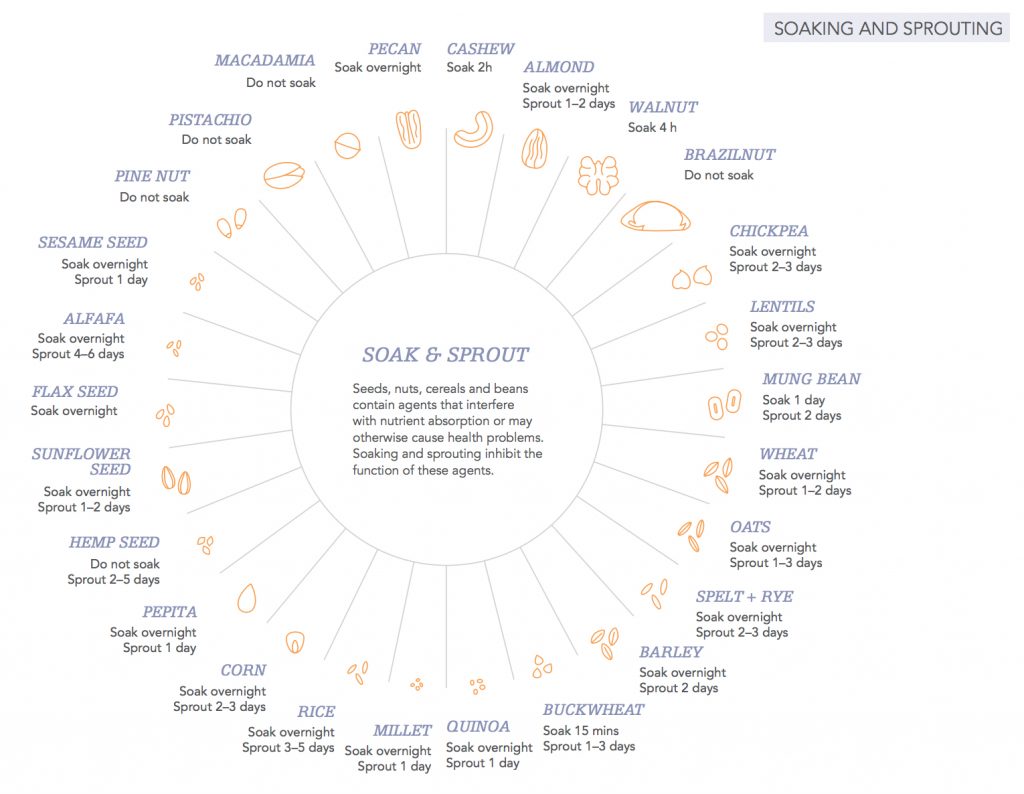
Diet Biohacking Lesson #13: Eggs Can Be Tricky
Eggs are not suitable for everyone. Some people are allergic to eggs, some suffer from hereditary dysfunctions in fatty-acid metabolism, and some people (around 20 % of the population in the US) have the ApoE4-allele (genetic variant) which might cause dysregulation of cholesterol metabolism. These individuals as well as diabetics, for example, should limit their egg consumption. There is a more realistic risk of developing a hypersensitivity to egg proteins as a result of regular egg consumption. Due to this, everyone who consumes eggs should take regular breaks in egg consumption.
When you do eat eggs, note the following helpful criteria:
• Fresh eggs sink in water, old eggs float.
• The egg whites of fresh eggs are firmer, the whites of older eggs are more watery.
• The more vivid yellow the yolk is, the more it contains fat-soluble vitamins and carotenoids.
• Avoid indoor eggs (including cage-free eggs) and caged eggs. Caged eggs carry an increased risk of salmonella.
• Vary the type of eggs you eat (for example quail, duck and goose).
• The main egg white protein consisting of albumin contains enzyme inhibitors when raw. Because of this, the egg white should be cooked.
• Avoid eating just the egg white by itself, as absent of the yolk, the conalbumin concentrated in egg white interferes with iron absorption, avidin hinders the absorption of the vitamin B complex.
• The yolk should be eaten raw or slightly cooked. Frying or boiling oxidizes fats, denatures proteins and destroys one half of the precious xanthophylls of the egg.
• Ideally, keep eggs in room temperature and use within 7–10 days. Refrigerated eggs will keep for approx. 30–45 days. Do not eat eggs that are old, have a broken shell or a watery egg white.
And…here's how the Biohackers' Guide on nutrition recommends you “cook the perfect egg”:
Place the eggs in water and raise the water temperature. When the water is boiling, remove from heat and leave to sit under a lid for 6 minutes. The internal temperature of the eggs will keep for several minutes, whereas the shells are much less likely to crack when removed from heat. Pour the hot water out and replace with cold water. Add 1 tsp of baking soda (this causes a raised pH of the water, which detaches the egg white from the shell). Leave the eggs in cold water for 2–5 minutes before eating.
Diet Biohacking Lesson #14: Make Quinoa Digestible
Check out this graph, which shows how the superfood quinoa becomes more and more digestible the more you treat it properly.
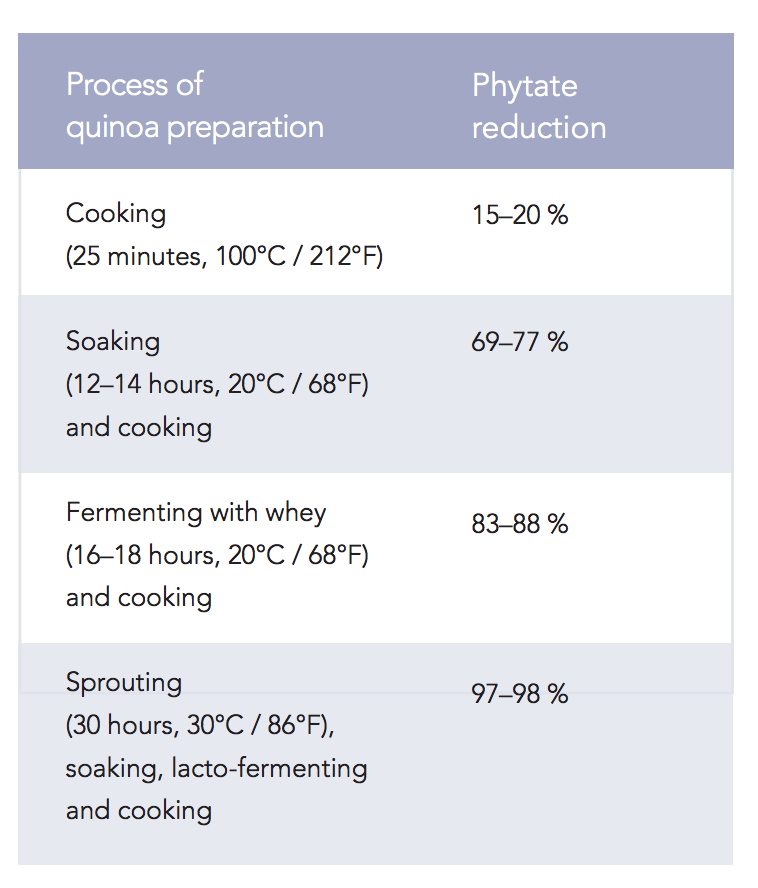
Diet Biohacking Lesson #15: Ripen Avocados Fast
In nature, avocados only ripen once they fall off the tree. You can ripen avocados by keeping them in room temperature. To speed up the process, place the avocados together with bananas in a small bag (for example a biowaste bag) overnight. Bananas are treated with ethylene, a plant hormone gas used to speed up the ripening process. This compound also accelerates the ripening of avocados.
Diet Biohacking Lesson #16: Make A Morning Tonic
Get hydrated first thing in the morning by squeezing the juice of half a lemon into approximately half a quart of water mixed with half a teaspoon of high quality salt. Lemon juice supports the digestive system and acts as a diuretic, increasing the need to urinate and hence removing waste products that have accumulated in the body overnight. Salt helps the adrenal glands produce cortisol needed for waking up – essential in the early hours of the morning.
Diet Biohacking Lesson #17: Easy, Fast Fat Spread Recipe
Use a blender to mix in equal amounts:
• As high quality butter as possible (grass-fed, unsalted butter)
• Cold-pressed organic virgin olive oil
• Spring water
For example, combine 100 g (1 stick) of butter, 1 dl (half a cup) of olive oil and 1 dl (half a cup) of water. Blend the ingredients and season with high quality salt and for example garlic or basil.
Diet Biohacking Lesson #18: Read The Biohacker's Coffee Manifesto
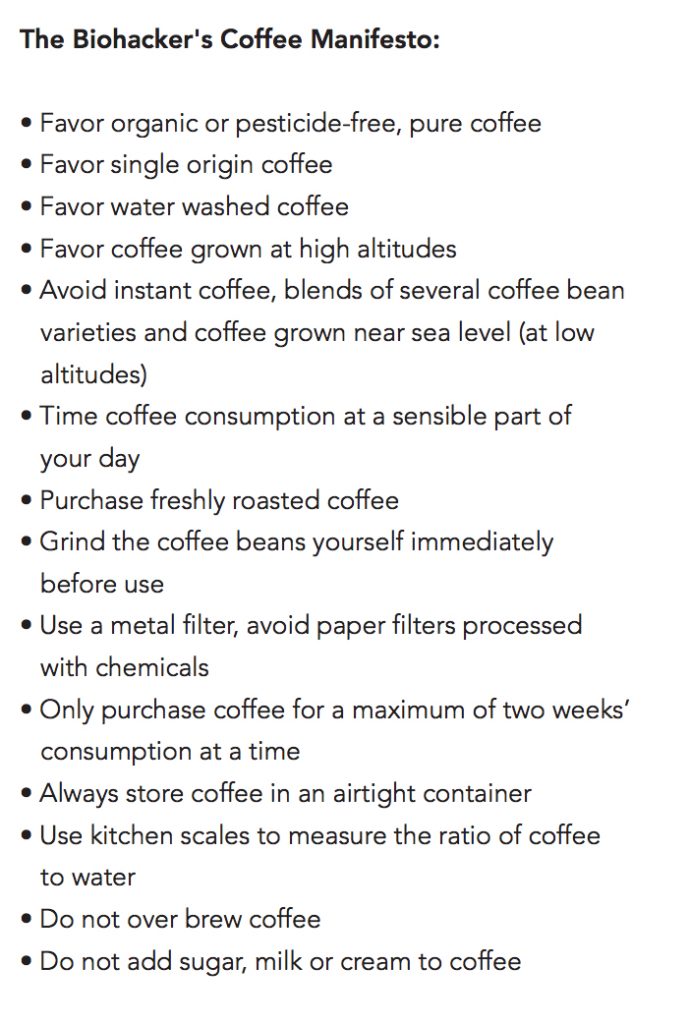
Diet Biohacking Lesson #19: Use Pistachio As A Probiotic
Compared to other nuts, pistachios are rich in beta-carotene and lutein. Pistachios balance blood sugar when eaten with a high-carbohydrate meal. Pistachios also reduce the oxidative stress of the system and improve cholesterol levels. But (and here's the new thing I learned) the consumption of pistachios has also been found to have a positive effect on the intestinal microbiome. Pistachio probiotics, baby.
Diet Biohacking Lesson #20: Use Mushrooms For Vitamin D
Dry your store-bought or self-harvested mushrooms in sunlight to multiply their vitamin D content. Studies conducted on shiitake mushrooms indicate that 100 g (3.5 oz) of fresh mushrooms, after having been placed in the sun for 12 hours, contained an additional 1000 µg vitamin D2.
Diet Biohacking Lesson #21: Beat A Hangover
The suggestions are based on supporting natural glutathione levels, removing toxic substances and restoring nutrients depleted by alcohol.
Before alcohol use:
• Eat meat (particularly turkey) with turmeric and egg yolks (amino acids)
• Eat 5–10 g (0.17–0.35 oz) chlorella
• Take 100 mg glutathione (preferably in a liposomal form)
• Milk thistle (silymarin) and fenugreek
During alcohol use:
• Take 500 mg absorbable vitamin C and 200 mg N-acetylcysteine (NAC) before each alcoholic drink
• Take 300 mg ginseng (accelerates the exit of acetaldehyde from the system)
• Drink glass of water with each alcoholic drink
After alcohol use:
• Use a strong Vitamin B complex
• Electrolytes (unrefined sea salt and coconut water)
• Eat broccoli (sulforaphane eliminates toxic acetaldehyde from the body)
• Eat fresh ginger (2–3 cm / 1-inch piece prevents nausea)
Before bed:
• 1–2 g (0.03–0.07 oz) activated carbon (binds the toxins formed)
Finally, should you forget to do any or all of the above, try this morning hangover cure:
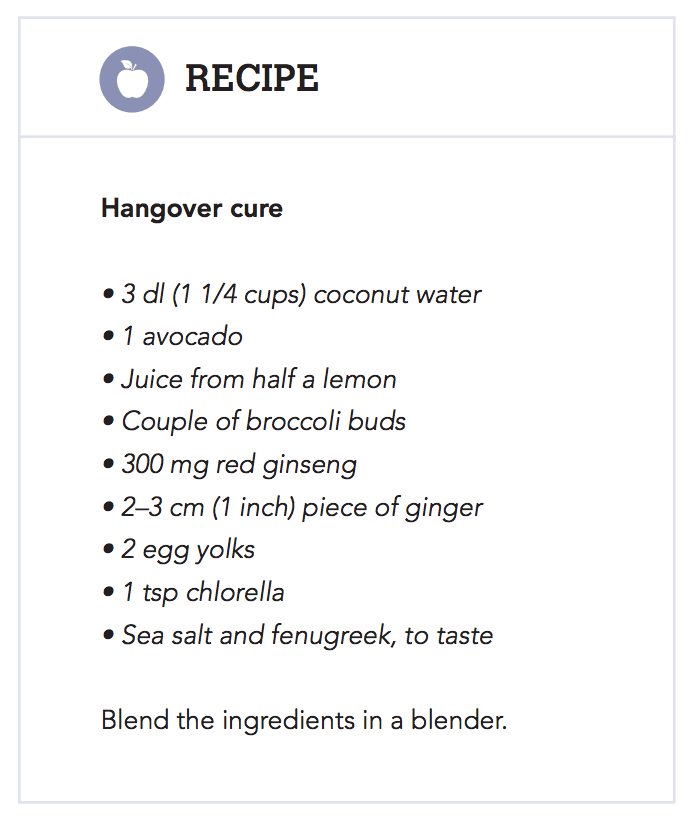
Summary
I've only scratched the surface of what is inside the Biohackers' Handbook on Nutrition.
Not kidding.
Like I mentioned earlier, we're talking 170+ pages, 100+ illustrations based on 450+ scientific references, and over a year of work from a team of six biohackers, including a medical doctor.
As Teemu and his team of experts continue to add content to their Biohackers' book series, I will continue to voraciously consume the content because, frankly, it is content from health enthusiasts after my own heart: folks who have one foot in the realm of ancestral, natural living and the other food in the realm of cutting-edge biohacking and better living through science.
So in summary…
…click here to get the Biohacker's Handbook on Nutrition now (or to peruse even more sample pages and images). The normal price on the book is $19.90. But in celebration of the Biohackers' Summit in London that just happened, Teemu is giving a pre-order price of $14.90, valid only until May 31. And that includes a money-back guarantee.
…when you follow that link above, you will also get the Biohackers' Handbook on Sleep for free (which is just as jam-packed with stuff you're not going to read anywhere else, but in this case, for sleep).
…then stay tuned to my blog for even more sections of the Biohackers' Handbooks revealed as more content gets churned out, particularly in the realms Exercise, Mind and Work.
…and finally, if you really dig this stuff and want to dive in headfirst, then come – along with yours truly, Dr. Rhonda Patrick, Teemu Arina and many more – to the November 18 Biohackers' Summit in Helsinki, Finland (use 10% discount code BEN), which is also organized by Teemu and his team and is the best marriage of ancestral living, wild plant foraging, smoke saunas, amazing food and biohacking you're ever going to experience.
Here's a quick video preview:
If that looks like a good time to you, then click here to get in now with 10% discount “BEN”.
Finally, as usual, leave your questions, comments and feedback below and I'll reply!

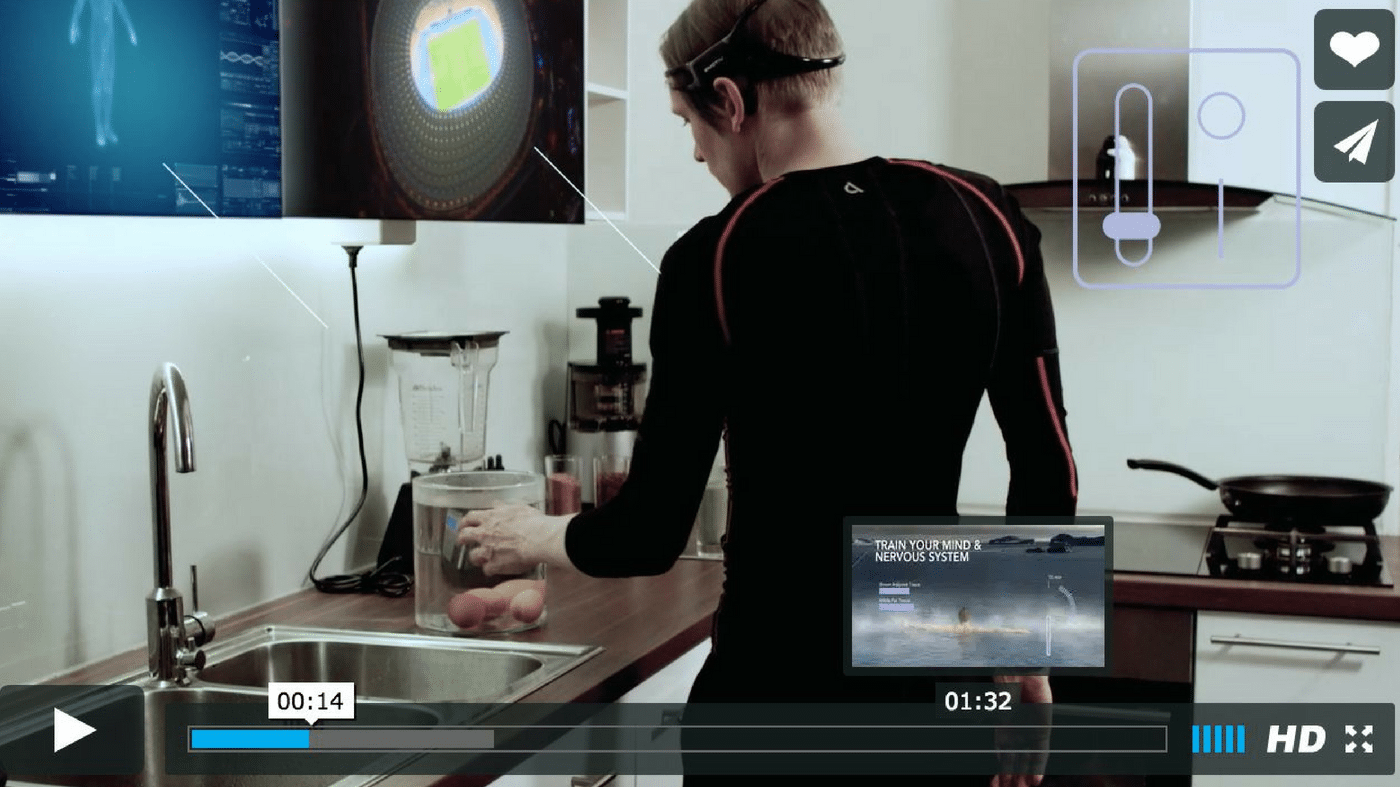
Do you have a recommended brand of DAO supplement?
Thanks!
Yep – check this one out: https://bengreenfieldfitness.com/dao
The link doesn’t work. Can you please post the DAO supplement again?
We are on it!
Ben, Is this book avaliable in paper form? I much prefer a book in hand.
Thank you,
Dr. Gene Flynn
USA
not yet…in the English language at least…
Would DNAfit be able to tell me if I have any of the sensitivities you mentioned? I didn’t think they got that granular.
No, DNAFit would not tell you what your food sensitivities are. It will tell you the best nutrition for your genetic makeup.
This guide is so comprehensive on how to improve your diet. I’m definitely guilty of not eating well and definitely don’t exercise enough. So although I’m not overweight at all, I’m definitely not as healthy as I could be. I’m also a HUGE fan of that coffee manifesto seeing as I am a die-hard coffee fanatic. I’ll definitely be trying to include some of this into my own diet.
Wow, awesome find, I’m definitely going to purchase the book. Regarding gene testing, I’m currently about to get my methlyation status checked, as I passed MTFHR okay, but I’m pretty sure I’m not methylating correctly.
Does the book discuss that specific area much? Anyway, I don’t care, I’ll still get it. I hate the term, but I love the concept of bio-hacking.
Hey dude,
I ended up purchasing through your link, and then there was no delivery of the videos… I can’t see how to get hold of these guys (there website is not up to date, as it’s still advertising the presale..) can you help a brother out?
Cheers mate
It seems like you accidentally discovered the hidden purchase link for the videos + books, which haven't launched yet. You will receive the videos once they get the first ones, so rest assured and you should already have the books!
for MTHR defect info, I recommend geneticgenie.com resources…
Also…for the MTHFR discussion, I'd be happy to help you via a personal one-on-one consult. Just go to https://bengreenfieldfitness.com/coaching. and then choose a 20 or 60 minute consult, whichever you'd prefer. I can schedule ASAP after you get that.
Awesome list of tips Ben- looks like everyone’s jumping onboard the salt and lemon/lime juice bandwagon.
I’m curious about the mushrooms though- how do they create more vitamin D if they’re dead? Is there a chemical in them that the sunlight reacts with? And is this really better than just taking vitamin D supplement along with some cod liver oil?
Mushrooms, even picked and dried ones, can perform the feat – which means that eating mushrooms that have been exposed to sunlight can be an excellent way to supplement your "D" levels.
In the summer of 2004, mycologist Paul Stamets discovered that the level of vitamin D in freshly picked, indoor- grown shiitake mushrooms rose from 110 IU (international units) to an astonishing 46,000 IU per 100 grams when the mushrooms were placed outdoors in the sun for just six hours with the gills facing up (when the gills were facing down, the level rose to 10,900 IU).
This means that eating just one gram of sun-treated shiitake – about one tenth of one mushroom – would give you 460 IU, close to the FDA's recommended daily dose of 400 IU, and about a quarter of Dr. Weil's recommended 2,000 IU. In his book, Mycelium Running: How Mushrooms Can Help Save the World, Stamets concluded, "(In) populations where vitamin D is seriously deficient, sun-exposed dried mushrooms can help address a serious health issue."
Hi Ben, re. lesson 16 (morning tonic of lemon and salt water), do you recommend drinking this first, or coffee with grass-fed butter and MCT? Thanks!
Definitely lemon and water first.
Thanks for the load of information. I have bought the book already but am still awaiting its release. In the meantime, I can’t check any of the genes/snps that you mention in my 23andme results.
For example: CYP1A2, there are a load of these genes (i presume each line is a different variant, and each variant has a unique SNP code). Is there a way to relate the 164A>C variant to a SNP?
Likewise with PNPLA3, MTHFR and all the other variant/gene pairs you mention.
The snp you mention: rs4988235, mine says genotype AG, which does not fit in to what you said. But if I expand the gene with the plus button on the left hand side I find this: dbSNP Genotype: CT. Is that what we’re looking for? If so, why are my results listing 2 different genotypes on the same row?
Hey Michael – best to book a consult to go through this, visit greenfieldfitnesssystems.com/ben and choose 20 or 60 mins and we'll get you scheduled.
Favor single origin coffee over a blend of varietals?
These guys have never had a world class blend (8-14 singles) or they wouldn’t make this assertion.
Hi Ben,
Thanks for all the great info as always!!
Question on #13: Eggs
I have the ApoE4 allele. I changed my diet a few years ago from vegan to consuming eggs, liver, butter and fish. Here is how my numbers have changed. Would you be concerned?
Vegan Now
Chol 147 299
TG 56 41
HDL 62 128
LDL 74 163
VLDL ? 8
Thanks for everything!
Dana
Book a consult at bengreenfieldfitness.com/coaching and choose 20 or 60 mins and we'll get you scheduled!
Tried to pre order via paypal and it wouldn’t work. Will try again tomorrow.
I think the CYP1A2 polymorphism you meant was 163A>C, not 164A>C.